My recent rereading of Alan Moore’s Miracleman got me thinking about his impact on comic books.
Alan Moore is considered by many to be the greatest comic book storyteller of the medium, an assessment that I believe is difficult to argue against. The modern view of Alan Moore has him oscillating somewhere between being a prophetic auteur of the medium or as a curmudgeon whose best days have long since passed. Regardless of how one feels about Moore, his approach to comic books deftly mixes mature themes with a suspicious eye towards the concept of heroism in a way that his made him stand well above any of his other contemporaries..
A cursory look at his work finds some of the biggest and most beloved stories in the comic oeuvre:
- Watchmen
- Killing Joke
- Swamp Thing
- V for Vendetta
- Marvelman/Miracleman
- From Hell
- The League of Extraordinary Gentlemen
These aren’t simply great stories so much as they are required reading for any serious comic book fan. Moore tends to stretch the vocabulary and boundaries of the medium with each work he publishes.
Writing such titans of the genre can make it easy to overlook other works that don’t quite pack the same commercial wallop. With such an omnipresent catalogue of books, there are bound to be works that get lost in the shuffle. Moore’s career has had him write for virtually everyone, including Marvel, DC, Image, and slew of other indie publishers.
Today, I want to offer up seven stories comic book readers might not have read from Alan Moore. And no, I won’t be recommending his time with WildC.A.T.S. from Image, but yes, that was an actual thing Moore did in the 90s.
[bs_smart_list_pack_start][/bs_smart_list_pack_start]
Promethea (Wildstorm/ABC)
While a majority of fans will point to Watchmen as Moore’s definitive work, I 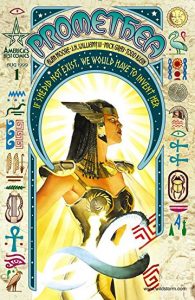 would argue that Promethea is his best. I can’t say for sure if Promethea is Moore’s own favorite work, but I suspect that he loved writing the book immensely because it mixes all of his favorite subjects and themes: magic, spirituality, sexuality, mysticism, and superheroes.
would argue that Promethea is his best. I can’t say for sure if Promethea is Moore’s own favorite work, but I suspect that he loved writing the book immensely because it mixes all of his favorite subjects and themes: magic, spirituality, sexuality, mysticism, and superheroes.
Promethea follows Sophie Bangs, an awkward college student who comes to manifest the mythical embodiment of the apocalypse, Promethea. The series starts out in a somewhat traditional superhero fashion, but quickly dovetails into a truly poetic exploration on Moore’s belief and philosophy on magic. The book’s scope is grand and sweeping, and quite unlike anything Moore has done before or since. Promethea is the only series that I have ever read that I intentionally reread each new issue several times to catch all of the hidden meanings both in the words and art.
Of course, Moore is always adept at choosing his collaborators, and Promethea is no exception. Joining Moore is artist J.H. Williams III, who provides a psychedelic, dreamlike quality to his visuals. Each page is chock full of mesmerizing art, detailed backgrounds, and some pretty funny background jokes (Weeping Gorilla still kills me). Even the covers are masterpieces, with the series providing homages to other artists and stories for pretty much its entire run. I would argue that this is the perfect Alan Moore book because of its unique mix of both writing and visual art.
Tom Strong (Wildstorm/ABC)
Like Promethea, Tom Strong is another one of the creator owned books from 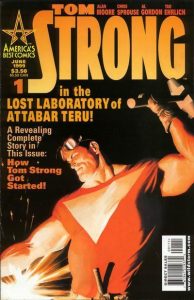 Moore’s America’s Best Comics. Moore brings in his love of the Silver Age and pulp heroes of yore by exploring science fiction and the superhero genre without his generally pessimistic and nihilistic flavoring. Not known for his rosy disposition as a person or in his work, Tom Strong is a delightful, positive read that finds Moore comfortable, loose, and most importantly, having fun.
Moore’s America’s Best Comics. Moore brings in his love of the Silver Age and pulp heroes of yore by exploring science fiction and the superhero genre without his generally pessimistic and nihilistic flavoring. Not known for his rosy disposition as a person or in his work, Tom Strong is a delightful, positive read that finds Moore comfortable, loose, and most importantly, having fun.
The science hero Tom Strong follows the title character and the misadventures of his family. The book feels a lot like a modern reimagining of the Fantastic Four without losing the campy, pulp-inspired action that marked the early Stan Lee and Jack Kirby run. The cast of supporting characters in the title is one of the strongest in any of Moore’s work. His wife Dhalua and daughter Tesla aid him in his adventures, while the robot Pnueman and ape Solomon provide comic relief and family support.
Tom Strong featured art from Chris Sprouse, who brings the Strong Family to life with his vibrant art. Sprouse makes the pages absolutely hum with excitement and action, true to form for the pulp feel Moore was aiming for in the series.
Tom Strong has actually made a return of late in the pages of Jeff Lemire’s The Terrifics. It’s nice to have Tom back, but his original series is a fantastic read that lacks the cynicism that much of Moore’s work embodies.
Supreme (Image)
I have already hyped Moore’s homage to Superman, Supreme, once before  on Nerds. However, I would be a terrible Alan Moore fan if I didn’t recommend it as one of the great Moore stories most folks haven’t read. With Supreme, the thinly veiled Superman pastiche from Rob Liefeld’s early Image work, Moore once again shows his talent with making treasure out of someone else’s trash.
on Nerds. However, I would be a terrible Alan Moore fan if I didn’t recommend it as one of the great Moore stories most folks haven’t read. With Supreme, the thinly veiled Superman pastiche from Rob Liefeld’s early Image work, Moore once again shows his talent with making treasure out of someone else’s trash.
Moore’s Supreme tackles all of the hallmarks and clichés of Silver Age Superman. Moore reinvents the character as he explores themes such as comic book history, retcons, and the cyclical nature of comic books. It’s a mix of Moore’s penchant for exploring the dueling nature of superhero nostalgia and postmodernism in comic books, which Moore essentially wrote the book on with Watchmen.
Moore’s many artistic collaborators on the Supreme include Rick Veitch, Kevin O’Neill, Chris Sprouse, Keith Giffen, Stephen Platt, and many others. The rotating artists gives the book an inconsistent feel at times, but it also fits with Moore’s framing of the series of exploring the past to gain insight on the present.
For anyone who wanted more of Whatever Happened to the Man of Tomorrow, Supreme provides fans with the “what if Alan Moore wrote Superman” scenario.
Captain Britain (Marvel UK)
While some comic scholars would consider Moore’s run on Captain Britain to 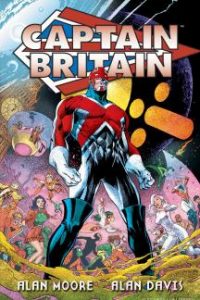 be one of his best, I have found that many fans still haven’t given this title a shot. In what is the earliest example of Moore doing so, he takes over a story midstream from another creators and changes all expectations about it, creating something horrifying and unique out of what should have been a mess.
be one of his best, I have found that many fans still haven’t given this title a shot. In what is the earliest example of Moore doing so, he takes over a story midstream from another creators and changes all expectations about it, creating something horrifying and unique out of what should have been a mess.
In his first and only major Marvel work, Moore takes Captain Britain (and Marvel) firmly into the multiverse. The story begins with Captain Britain being warned by his alternate universe counterpart Captain UK that future Prime Minister Jim Jaspers poses a problem to all superheroes. Her universe’s version of Jaspers has an assassin android, The Fur,y kill all superheroes… and now that droid has infiltrated the 616 (Moore’s newly minted label for the Marvel Universe)! The story pits Captain Britain against the reality warping Jim Jaspers, an unassuming villain that nonetheless shines.
Moore’s take on Captain Britain is immeasurably aided by the excellent artwork provided by Alan Davis. The creative team presents a story that is both unnerving and consequential. Moore’s Captain Britain has all the gravitas that his Marvelman/Miracleman work had, while giving him the rare opportunity to play with some of Marvel’s toys.
The Lovecraft Trilogy: The Courtyard/Neonomicon/Providence (Avatar)
It might be kind of cheating to lump three books together, but they are related! 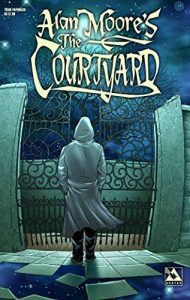 One of Moore’s consistent, lifelong obsessions is with the work of H.P. Lovecraft. Lovecraft has influenced countless writers, but Moore enjoys bringing in Lovecraftian themes and creatures into his work more than most. One of his more overt Lovecraft homages are his three Avatar miniseries: The Courtyard, Neonomicon, and Providence. The three books weave together a creepy and adults only story of Moore’s interpretation of Lovecraft’s famous mythos work.
One of Moore’s consistent, lifelong obsessions is with the work of H.P. Lovecraft. Lovecraft has influenced countless writers, but Moore enjoys bringing in Lovecraftian themes and creatures into his work more than most. One of his more overt Lovecraft homages are his three Avatar miniseries: The Courtyard, Neonomicon, and Providence. The three books weave together a creepy and adults only story of Moore’s interpretation of Lovecraft’s famous mythos work.
The Courtyard is based off the prose story of the same name by Alan Moore, with Anthony Johnson adapting the story of FBI agent Aldo Sax who is tasked with investigating three ritualistic murders. Like anything Lovecraftian, what follows is the agent’s descent into madness and hysteria.
Its sequel, Neonomicon, follows more FBI agents who are on the trail of a copycat killer in the wake of the fallout from Agent Sax’s loss of sanity in the first series. It’s as brutal and unforgiving as anything Moore has ever written.
Providence acts as primarily a prequel to both books. Set in 1919, Providence follows a writer attempting to explore the occult happenings in New England. I won’t spoil anything, but Providence also serves as a sequel to The Courtyard and Neonomicon as well.
Jacen Burrows provides the art for all three series, which is brutal and grim. As with almost anything written by Moore in recent years, each of the three miniseries are strictly for adults due to the violence and sexual nature of the books. But don’t let that deter you from reading the books. While it can be barborous at times, Moore gives an unflinching view of the Lovecraftian mythos
The Nemo Trilogy: Heart of Ice/Rose of Berlin/River of Ghosts (Top Shelf)
This is another cheat, but again, all three books are related and worth the 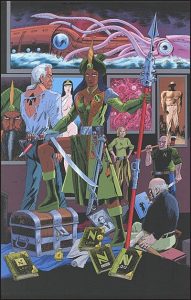 reading! One of Moore’s most successful modern books is his League of Extraordinary Gentlemen titles. While those main books get a lot of attention, the three Nemo graphic novels each provide a 72-page window into a Captain Nemo’s daughter, Janni Dakkar.
reading! One of Moore’s most successful modern books is his League of Extraordinary Gentlemen titles. While those main books get a lot of attention, the three Nemo graphic novels each provide a 72-page window into a Captain Nemo’s daughter, Janni Dakkar.
Though each title is self-contained, the three three books combine to tell the story of Janni Dakkar, who was first introduced in the third League of Extraordinary Gentlemen series, Century. Like that series, each of the three books in the Nemo trilogy finds Janni in a different decade in the 20th Century.
As with all of the League books, award winning artists Kevin O’Neill provides his extraordinary talents to the series. His highly stylistic art is perfect for Moore’s sensibilities, as the two are still frequent collaborators. The Nemo trilogy succeeds at creating a self-contained story that explores pockets of the League world that haven’t been explored in the main narrative up to this point.
Fashion Beast (Avatar)
My last recommendation is a usual offering from Alan Moore. Fashion Beast 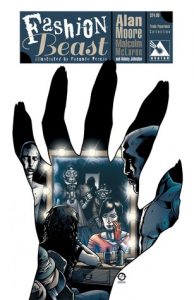 is another Moore adaptation from Anthony Johnson. Based on 1985 screenplay written by Alan Moore and English eccentric Malcolm McLaren (famed manager of the Sex Pistols), the 2012 series Fashion is a modern retelling of Beauty and the Beast.
is another Moore adaptation from Anthony Johnson. Based on 1985 screenplay written by Alan Moore and English eccentric Malcolm McLaren (famed manager of the Sex Pistols), the 2012 series Fashion is a modern retelling of Beauty and the Beast.
Fashion Beast takes place in a dystopian England. The story follows working class stiff Doll who auditions to become a model for popular fashion designer, the reclusive and supposedly deformed Celestine. Over the course of the ten issue series, palace intrigue fuels Doll’s growth in the fashion industry and in her confidence.
Argentinian Facundo Percio provides art on the series, which reminds me of Moore’s 80s collaborators Dave Gibbons and David Lloyd. Reading the adaptation definitely reminds me of classic Moore. That’s not surprising since this screenplay was written in his most creatively fertile period of the mid-80s.
Avatar heralded Fashion Beast as Moore’s lost classic when it was published nearly 30 years later, and I’m inclined to agree. Fans wanting something more akin in tone to Watchmen or V for Vendetta should definitely check Fashion Beast out.
[bs_smart_list_pack_end][/bs_smart_list_pack_end]
It’s tough to pick seven books from Alan Moore to recommend without hitting the usual suspects. As a huge fan, I’m of the general opinion that readers can’t really go wrong with picking up any book that has Alan Moore’s name on the cover. You might not like the book overall, but Moore has a way of challenging the conventions of the medium as much as he is challenging us as readers.
I tried to recommend a variety of books that showcase Alan Moore’s ingenious, multifaceted talents in his approach to writing comic books. I hope there is at least one book that sounds interesting to our readership!
Let us know what some of your favorite Alan Moore works are by following us on Twitter or by discussing this article on our Nerds on Earth 616 Facebook group.

